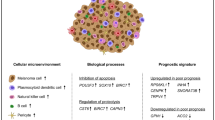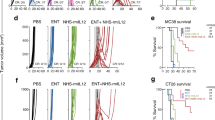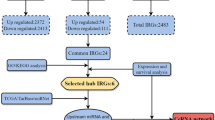Abstract
Toll-like receptor-3 (TLR3), a member of an immune recognition receptor family, is widely expressed in tumour cells and has been shown previously to have the capacity to not only activate immune signalling pathways, but also to exert proapoptotic activity in some cells. We show here that HaCaT human keratinocytes are susceptible to apoptosis induction by the TLR3 ligand poly I:C, and use these cells as a model to analyse the apoptotic signalling pathway. Although the BH3-only protein Noxa was transcriptionally induced by poly I:C and translocated to mitochondria, RNAi experiments showed that the BH3-only proteins Noxa, Bim and Puma were individually dispensable for poly I:C-induced apoptosis. Instead, poly I:C-induced activation of caspase-8 via TLR3 and its adapter TRIF was required for apoptosis. In human melanoma cell lines poly I:C failed to induce apoptosis unless protein synthesis was blocked. Significantly, sensitisation towards poly I:C-dependent caspase-8 activation and apoptosis in melanoma cells was also achieved by the synthetic Smac mimetic/inhibitor of apoptosis protein (IAP) antagonist, LBW242, or by specific downregulation of cIAP1 by siRNA. Inactivation of caspase-8 by CrmA overexpression reduced poly I:C/LBW242-induced apoptosis. These results indicate that the proapoptotic activity of TLR3/TRIF/caspase-8 in melanoma cells is under the control of IAPs, and the use of novel Smac mimetics might be a feasible approach to target melanoma.
Similar content being viewed by others
Log in or create a free account to read this content
Gain free access to this article, as well as selected content from this journal and more on nature.com
or
Abbreviations
- Bak:
-
Bcl-2 homologous antagonist/killer
- Bax:
-
Bcl-2associated X protein
- Bcl-2:
-
B-cell lymphoma protein 2
- Bcl-XL:
-
Bcl-2-like protein 1
- Bid:
-
BH3 interacting domain death agonist
- Bim:
-
Bcl-2-like protein 11
- cIAP1/2:
-
cellular IAP1,2
- CHX:
-
cycloheximide
- CrmA:
-
caspase-8 inhibitor from cowpox virus
- DISC:
-
death-inducing signaling complex
- FLIP:
-
CASP8 and FADD-like apoptosis regulator
- GAPDH:
-
Glyceraldehyde 3-phosphate dehydrogenase
- IAP:
-
inhibitor of apoptosis protein
- IFN:
-
interferon
- IL-8:
-
interleukin 8
- MyD88:
-
myeloid differentiation primary response protein-88
- Mcl-1:
-
induced myeloid leukemia cell differentiation protein
- Noxa:
-
phorbol-12-myristate-13-acetate-induced protein 1
- PI:
-
propidium iodide
- poly I:C/pIC:
-
polyinosinic:polycytidylic acid
- Puma:
-
p53 upregulated modulator of apoptosis
- p53:
-
tumor protein 53
- TLR:
-
Toll-like receptors
- TNF:
-
tumor necrosis factor
- TRADD:
-
tumor necrosis factor receptor type 1-associated death domain protein
- TRAF6:
-
TNF receptor associated factor family protein 6
- TRIF:
-
TIR-domain-containing adapter-inducing interferon (IFN)
- XIAP:
-
X-linked inhibitor of apoptosis protein
- zVAD-fmk:
-
(carbobenzoxy-valyl-alanyl-aspartyl-[O-methyl]- fluoromethylketone)
References
Takeda K, Akira S . Toll-like receptors. Curr Protoc Immunol 2007; Chapter 14 Unit 14 12.
Aliprantis AO, Yang RB, Weiss DS, Godowski P, Zychlinsky A . The apoptotic signaling pathway activated by Toll-like receptor-2. EMBO J 2000; 19: 3325–3336.
Aliprantis AO, Yang RB, Mark MR, Suggett S, Devaux B, Radolf JD et al. Cell activation and apoptosis by bacterial lipoproteins through toll-like receptor-2. Science 1999; 285: 736–739.
Ruckdeschel K, Pfaffinger G, Haase R, Sing A, Weighardt H, Hacker G et al. Signaling of apoptosis through TLRs critically involves toll/IL-1 receptor domain-containing adapter inducing IFN-beta, but not MyD88, in bacteria-infected murine macrophages. J Immunol 2004; 173: 3320–3328.
Krieg AM . Development of TLR9 agonists for cancer therapy. J Clin Invest 2007; 117: 1184–1194.
Hengartner MO . The biochemistry of apoptosis. Nature 2000; 407: 770–776.
Hacker G, Weber A . BH3-only proteins trigger cytochrome c release, but how? Arch Biochem Biophys 2007; 462: 150–155.
Adams JM, Cory S . Bcl-2-regulated apoptosis: mechanism and therapeutic potential. Curr Opin Immunol 2007; 19: 488–496.
Sun Y, Leaman DW . Involvement of Noxa in cellular apoptotic responses to interferon, double-stranded RNA, and virus infection. J Biol Chem 2005; 280: 15561–15568.
Salaun B, Lebecque S, Matikainen S, Rimoldi D, Romero P . Toll-like receptor 3 expressed by melanoma cells as a target for therapy? Clin Cancer Res 2007; 13 (15 Part 1): 4565–4574.
Salaun B, Coste I, Rissoan MC, Lebecque SJ, Renno T . TLR3 can directly trigger apoptosis in human cancer cells. J Immunol 2006; 176: 4894–4901.
Jiang Q, Wei H, Tian Z . Poly I:C enhances cycloheximide-induced apoptosis of tumor cells through TLR3 pathway. BMC Cancer 2008; 8: 12.
Scaffidi C, Fulda S, Srinivasan A, Friesen C, Li F, Tomaselli KJ et al. Two CD95 (APO-1/Fas) signaling pathways. EMBO J 1998; 17: 1675–1687.
Kawai T, Akira S . Antiviral signaling through pattern recognition receptors. J Biochem 2007; 141: 137–145.
Vince JE, Wong WW, Khan N, Feltham R, Chau D, Ahmed AU et al. IAP antagonists target cIAP1 to induce TNFalpha-dependent apoptosis. Cell 2007; 131: 682–693.
Varfolomeev E, Blankenship JW, Wayson SM, Fedorova AV, Kayagaki N, Garg P et al. IAP antagonists induce autoubiquitination of c-IAPs, NF-kappaB activation, and TNFalpha-dependent apoptosis. Cell 2007; 131: 669–681.
Meylan E, Burns K, Hofmann K, Blancheteau V, Martinon F, Kelliher M et al. RIP1 is an essential mediator of Toll-like receptor 3-induced NF-kappa B activation. Nat Immunol 2004; 5: 503–507.
Ermolaeva MA, Michallet MC, Papadopoulou N, Utermohlen O, Kranidioti K, Kollias G et al. Function of TRADD in tumor necrosis factor receptor 1 signaling and in TRIF-dependent inflammatory responses. Nat Immunol 2008; 9: 1037–1046.
Peter ME . The flip side of FLIP. Biochem J 2004; 382 (Part 2): e1–e3.
Jiang Z, Mak TW, Sen G, Li X . Toll-like receptor 3-mediated activation of NF-kappaB and IRF3 diverges at Toll-IL-1 receptor domain-containing adapter inducing IFN-beta. Proc Natl Acad Sci USA 2004; 101: 3533–3538.
Takeda K, Kaisho T, Akira S . Toll-like receptors. Annu Rev Immunol 2003; 21: 335–376.
Galluzzi L, Brenner C, Morselli E, Touat Z, Kroemer G . Viral control of mitochondrial apoptosis. PLoS Pathog 2008; 4: e1000018.
Kaiser WJ, Offermann MK . Apoptosis induced by the toll-like receptor adaptor TRIF is dependent on its receptor interacting protein homotypic interaction motif. J Immunol 2005; 174: 4942–4952.
Han KJ, Su X, Xu LG, Bin LH, Zhang J, Shu HB . Mechanisms of the TRIF-induced interferon-stimulated response element and NF-kappaB activation and apoptosis pathways. J Biol Chem 2004; 279: 15652–15661.
Peter ME, Krammer PH . The CD95(APO-1/Fas) DISC and beyond. Cell Death Differ 2003; 10: 26–35.
Hsu H, Xiong J, Goeddel DV . The TNF receptor 1-associated protein TRADD signals cell death and NF-kappa B activation. Cell 1995; 81: 495–504.
Cusson-Hermance N, Khurana S, Lee TH, Fitzgerald KA, Kelliher MA . Rip1 mediates the Trif-dependent toll-like receptor 3- and 4-induced NF-{kappa}B activ. J Biol Chem 2005; 280: 36560–36566.
Hacker H, Karin M . Regulation and function of IKK and IKK-related kinases. Sci STKE 2006; 2006: re13.
Gaither A, Porter D, Yao Y, Borawski J, Yang G, Donovan J et al. A Smac mimetic rescue screen reveals roles for inhibitor of apoptosis proteins in tumor necrosis factor-alpha signaling. Cancer Res 2007; 67: 11493–11498.
Friboulet L, Pioche-Durieu C, Rodriguez S, Valent A, Souquere S, Ripoche H et al. Recurrent overexpression of c-IAP2 in EBV-associated nasopharyngeal carcinomas: critical role in resistance to Toll-like receptor 3-mediated apoptosis. Neoplasia 2008; 10: 1183–1194.
Wang CY, Mayo MW, Korneluk RG, Goeddel DV, Baldwin AS, Jr . NF-kappaB antiapoptosis: induction of TRAF1 and TRAF2 and c-IAP1 and c-IAP2 to suppress caspase-8 activation. Science 1998; 281: 1680–1683.
Morikawa T, Sugiyama A, Kume H, Ota S, Kashima T, Tomita K et al. Identification of Toll-like receptor 3 as a potential therapeutic target in clear cell renal cell carcinoma. Clin Cancer Res 2007; 13: 5703–5709.
Boukamp P, Petrussevska RT, Breitkreutz D, Hornung J, Markham A, Fusenig NE . Normal keratinization in a spontaneously immortalized aneuploid human keratinocyte cell line. J Cell Biol 1988; 106: 761–771.
Smalley KS, Contractor R, Haass NK, Kulp AN, Atilla-Gokcumen GE, Williams DS et al. An organometallic protein kinase inhibitor pharmacologically activates p53 and induces apoptosis in human melanoma cells. Cancer Res 2007; 67: 209–217.
Satyamoorthy K, Li G, Gerrero MR, Brose MS, Volpe P, Weber BL et al. Constitutive mitogen-activated protein kinase activation in melanoma is mediated by both BRAF mutations and autocrine growth factor stimulation. Cancer Res 2003; 63: 756–759.
Alves NL, Derks IA, Berk E, Spijker R, van Lier RA, Eldering E . The Noxa/Mcl-1 axis regulates susceptibility to apoptosis under glucose limitation in dividing T cells. Immunity 2006; 24: 703–716.
Ploner C, Rainer J, Niederegger H, Eduardoff M, Villunger A, Geley S et al. The BCL2 rheostat in glucocorticoid-induced apoptosis of acute lymphoblastic leukemia. Leukemia 2008; 22: 370–377.
Ui-Tei K, Naito Y, Takahashi F, Haraguchi T, Ohki-Hamazaki H, Juni A et al. Guidelines for the selection of highly effective siRNA sequences for mammalian and chick RNA interference. Nucleic Acids Res 2004; 32: 936–948.
Dewson G, Snowden RT, Almond JB, Dyer MJ, Cohen GM . Conformational change and mitochondrial translocation of Bax accompany proteasome inhibitor-induced apoptosis of chronic lymphocytic leukemic cells. Oncogene 2003; 22: 2643–2654.
Eskes R, Desagher S, Antonsson B, Martinou JC . Bid induces the oligomerization and insertion of Bax into the outer mitochondrial membrane. Mol Cell Biol 2000; 20: 929–935.
Acknowledgements
We thank Dr Leigh Zawel (Novartis, Cambridge) for generously providing LBW242. We are grateful to Christian Ploner (Medical University of Innsbruck, Innsbruck, Austria) for providing the shScrambled vector and the shRNA construct directed against Bim. We thank Daria Loos for experimental assistance. This work was supported by grants from the Deutsche Forschungsgemeinschaft to GH (Ha2128) and to RB (GK 1202), and from the Deutsche Krebshilfe to RB (grant 107805).
Author information
Authors and Affiliations
Corresponding author
Ethics declarations
Competing interests
The authors declare no conflict of interest.
Additional information
Edited by F Madeo
Supplementary Information accompanies the paper on Cell Death and Differentiation website
Supplementary information
Rights and permissions
About this article
Cite this article
Weber, A., Kirejczyk, Z., Besch, R. et al. Proapoptotic signalling through Toll-like receptor-3 involves TRIF-dependent activation of caspase-8 and is under the control of inhibitor of apoptosis proteins in melanoma cells. Cell Death Differ 17, 942–951 (2010). https://doi.org/10.1038/cdd.2009.190
Received:
Revised:
Accepted:
Published:
Issue date:
DOI: https://doi.org/10.1038/cdd.2009.190
Keywords
This article is cited by
-
Mitochondria supply sub-lethal signals for cytokine secretion and DNA-damage in H. pylori infection
Cell Death & Differentiation (2022)
-
Immunotherapeutic role of cabazitaxel treatment in the activation of TLR3 signalling in metastatic castration-resistant prostate cancer in vitro
Molecular Biology Reports (2022)
-
Receptor-interacting protein kinase 1 is a key mediator in TLR3 ligand and Smac mimetic-induced cell death and suppresses TLR3 ligand-promoted invasion in cholangiocarcinoma
Cell Communication and Signaling (2020)
-
Radio-sensitization of head and neck cancer cells by a combination of poly(I:C) and cisplatin through downregulation of survivin and c-IAP2
Cellular Oncology (2019)
-
Release of c-FLIP brake selectively sensitizes human cancer cells to TLR3-mediated apoptosis
Cell Death & Disease (2018)



